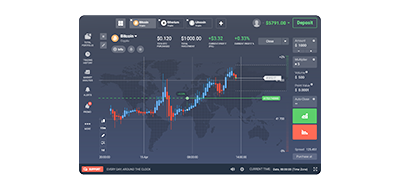Back
Contents
What is Triangular Arbitrage: Definition and Example

Trading

Demetris Makrides
Senior Business Development Manager

Vitaly Makarenko
Chief Commercial Officer
Triangular arbitrage is a sophisticated financial strategy used to exploit inefficiencies in the currency exchange markets, where discrepancies in exchange rates open opportunities for profit. This method involves making three consecutive currency exchanges, starting with one currency and concluding with its re-conversion, potentially yielding a risk-free profit. Understanding the mechanics of triangular arbitrage illuminates aspects of market inefficiency and illustrates the high-speed nature of contemporary trading, which is driven largely by automated systems.
Definition of Triangular Arbitrage
Triangular arbitrage is a financial strategy employed in the foreign exchange market that exploits inefficiencies in the currency exchange rates among three different currencies to earn a profit. The essence of this strategy lies in the sequence of trades that completes a triangular loop, beginning and ending with the same currency. The goal is to leverage discrepancies in exchange rates such that the trader concludes the series of trades with more of the initial currency than they started with, achieving a profit without taking on significant risk.
Core Concept
Triangular arbitrage hinges on the concept of relative value among currencies that are misaligned in the Forex market. It involves three key steps, each corresponding to a trade between two currencies. The success of this arbitrage strategy does not depend on the movement of the market in terms of direction but rather on the realization of these mispricings across different currency pairs at a given moment.
Temporary discrepancies in currency exchange rates can create the potential for triangular arbitrage. These discrepancies may arise due to several factors, including asynchronous market updates, varying levels of liquidity in different financial centers, or delays in disseminating currency market information. Such conditions create small windows of opportunity for arbitrage.
In theory, triangular arbitrage helps maintain the efficiency of the foreign exchange market by correcting these irregularities. Traders who engage in this practice use their capital to adjust the supply and demand across the markets, thus aiding in the alignment of exchange rates to their true values as dictated by market fundamentals.
The Role of Speed and Technology
In triangular arbitrage, speed and technology are critical due to the rapid self-correction mechanisms inherent in the Forex market. Arbitrage opportunities may exist for only a few seconds before exchange rates adjust to close any discrepancies. Traders employ advanced computational technologies and sophisticated algorithms to capitalize on these fleeting opportunities.
- Advanced Computational Technologies: Traders use systems designed to continuously scan the Forex market, identifying potential arbitrage opportunities instantaneously. These technologies detect opportunities quickly and assess profitability after factoring in transaction costs.
- Algorithmic Trading: Algorithms are essential for executing a sequence of trades at extremely high speeds. They can process vast amounts of data, interpret complex market conditions, and make instantaneous trading decisions without human intervention. The speed and precision of these algorithms are critical, as even a millisecond delay can impact a trade’s profitability.
- Integration with Electronic Trading Platforms: Effective implementation of triangular arbitrage strategies requires integrating these algorithms with electronic trading platforms that provide direct access to market data and trading execution. This integration minimizes latency—the delay between identifying an opportunity and executing the trade.
The competitive nature of the Forex market has spurred a technological arms race among firms to develop faster and more efficient systems. This includes hardware advancements for quicker data processing and software enhancements for improved decision-making algorithms, as success often hinges on the ability to quickly and accurately execute trades in a market where milliseconds can mean the difference between profit and loss.
Mechanics and Execution
The mechanics and execution of triangular arbitrage hinge on the swift identification and exploitation of inefficiencies in currency exchange rates.
Identifying Arbitrage Opportunities
The process begins by identifying potential arbitrage opportunities where the actual cross-exchange rates in the market do not align with the expected cross rates. For instance, an arbitrage opportunity is present if the product of the exchange rates from USD to EUR and EUR to GBP does not equal the direct exchange rate from USD to GBP.
Executing the Trades
- First Trade: The trader exchanges the initial currency for a second currency at the prevailing market rate. This step is critical as it sets the foundation for the arbitrage cycle.
- Second Trade: The second currency is then traded for a third currency, again using the current exchange rate. This step exploits the first identified discrepancy.
- Final Trade: Finally, the third currency is exchanged back into the initial currency. The rate at which this exchange occurs is vital as it determines whether the overall transaction results in a profit.
Detailed Example of Triangular Arbitrage
Consider the following real-world scenario to illustrate the execution of triangular arbitrage:
- Exchange Rates:
- USD/EUR = 0.85
- EUR/GBP = 0.70
- GBP/USD = 1.50.
- Implied Rate Calculation: An arbitrageur calculates the implied USD/GBP rate by multiplying the USD/EUR and EUR/GBP rates (0.85 * 0.70 = 0.595). However, the market’s direct exchange rate for GBP/USD, which implies a USD/GBP rate of 0.6667 (1/1.50), presents a discrepancy from the calculated rate.
Arbitrage Execution Steps
- Step 1: The arbitrageur starts with $100,000 USD and converts it to Euros at the USD/EUR rate of 0.85, receiving 85,000 Euros.
- Step 2: These 85,000 Euros are then converted to British Pounds at the EUR/GBP rate of 0.70, yielding 59,500 GBP.
- Step 3: Finally, the 59,500 GBP are converted back into USD at the GBP/USD rate of 1.50, resulting in $119,000 USD.
Outcome
The arbitrage cycle starts with $100,000 and ends with $119,000, thus securing a profit of $19,000 from the arbitrage transactions. This example highlights the profit potential when discrepancies between the implied and actual exchange rates are efficiently and quickly exploited.
The successful execution of triangular arbitrage strategies requires an understanding of currency market dynamics and relies heavily on the capability to perform rapid calculations and execute swift trades. Advanced trading platforms and algorithmic trading have become essential tools in this process, enabling traders to take advantage of arbitrage opportunities that may last only a few seconds before market forces eliminate the inefficiency.
Challenges and Considerations
While triangular arbitrage can offer significant profits, the strategy has inherent challenges and considerations that can affect its viability. Understanding these factors is crucial for any trader leveraging this arbitrage technique effectively.
Fleeting Opportunities and Market Correction
One of the primary challenges of triangular arbitrage is the transient nature of the opportunities it exploits. Currency markets are highly efficient, and any discrepancies in exchange rates are typically corrected within seconds. This rapid adjustment means the window for exploiting these opportunities is extremely short. Traders must be able to identify and act on these opportunities before they disappear quickly. This necessity for speed makes triangular arbitrage predominantly viable only for those with access to automated trading technologies that can execute transactions almost instantaneously.
High-Speed Automated Trading Systems
Traders must use advanced automated trading systems to capitalize on triangular arbitrage’s brief opportunities. These systems are designed to monitor multiple currency pairs simultaneously, detect potential arbitrage opportunities, calculate their profitability, and execute the required trades in a fraction of a second. The effectiveness of these systems is crucial, as even a slight delay in execution can render an arbitrage opportunity unprofitable. Moreover, the cost of maintaining such sophisticated technology can be substantial, necessitating a significant volume of trades to justify the investment.
Impact of Transaction Costs
The feasibility of triangular arbitrage heavily depends on the transaction costs involved, which include bid-ask spreads, trading fees, and any potential slippage. For an arbitrage opportunity to be profitable, the total gain from the trades must exceed these costs. Since each arbitrage sequence involves multiple trades, the cumulative cost can quickly erode profit margins. Traders need to have precise mechanisms in place to calculate these costs in real time and determine the net profitability of potential opportunities before executing trades.
Liquidity and Market Impact
Another consideration is the impact of trades on the market. Triangular arbitrage often involves significant sums of money, and large trades can affect the market prices of the currencies involved. This market impact can lead to slippage, where the actual execution price of a trade differs from the expected price, potentially reducing the profitability of the arbitrage. Additionally, higher liquidity in the currency pairs involved generally reduces this market impact, making popular currency pairs more suitable for triangular arbitrage.
Regulatory and Legal Factors
Traders must also be aware of the regulatory environment in which they operate. Different countries and regions may have specific regulations that affect the ability to perform rapid, high-volume trading. Compliance with these regulations is essential to avoid legal repercussions and ensure that trading activities continue without interruptions.
Conclusion
Triangular arbitrage is a complex but potentially lucrative trading strategy that plays a significant role in maintaining the efficiency of the foreign exchange markets. It requires access to fast, automated trading technologies and an acute awareness of transaction costs. While not without risks, for those equipped with the right tools and expertise, triangular arbitrage offers a compelling avenue for profit in the fast-paced world of currency trading.
Updated:
December 18, 2024
12 March, 2025
NEW POST FOR TESTING BLOG AND WP
What is Lorem Ipsum? test link with http Lorem Ipsum is simply dummy text of the printing and typesetting industry. Lorem Ipsum has been the industry’s standard dummy text ever since the 1500s, when an unknown printer took a galley of type and scrambled it to make a type specimen book. It has survived not only […]



